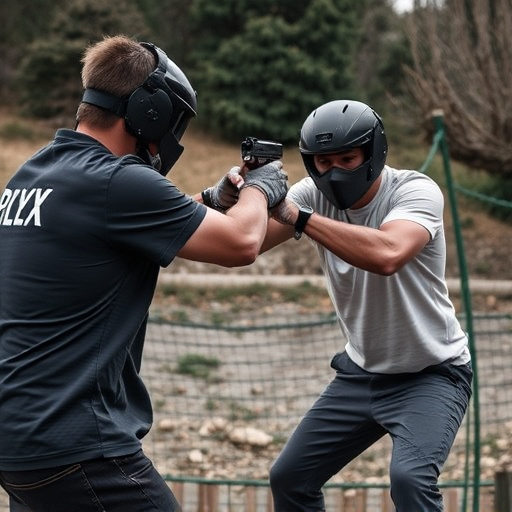Swift action is crucial for pepper spray exposure treatment. Flushing eyes with clean water for 15 minutes reduces irritation. Inhalation victims need fresh air and medical attention. Prompt medical care is essential for persistent symptoms or breathing difficulties. Early intervention, including water or eye irrigation, can significantly reduce symptoms within 15-20 minutes. De-escalation tactics, combining physical and psychological strategies, are trained by law enforcement to manage riot control scenarios effectively.
Riot control agents, including pepper spray, are powerful tools used by law enforcement for crowd management. However, their proper application and understanding of associated risks are paramount to ensure public safety. This article delves into critical aspects of pepper spray use, focusing on exposure risks, treatment guidelines for eye and skin irritation, and optimal time frames for effective de-escalation. By exploring these key areas, we aim to provide essential insights for law enforcement professionals.
- Pepper Spray: Understanding Exposure Risks
- Treatment Guidelines for Eye and Skin Irritation
- Optimal Time Frames for Effective De-escalation
Pepper Spray: Understanding Exposure Risks
Pepper spray, a common riot control agent used by law enforcement, poses unique risks and requires understanding its effects and exposure treatment. When deployed, pepper spray can cause severe irritation to the eyes, nose, throat, and lungs, leading to temporary blindness, coughing, and difficulty breathing. The severity of symptoms depends on various factors such as concentration, duration of exposure, and individual sensitivity.
Exposure treatment for pepper spray is crucial and should commence immediately after contact. It involves thorough eye flushing with clean water for at least 15 minutes to prevent irritation and damage. For inhalation, victims should be moved to an area with fresh air and receive respiratory support if needed. Medical attention should be sought promptly, especially for individuals experiencing persistent symptoms or difficulties breathing, as these could indicate more severe complications from pepper spray exposure.
Treatment Guidelines for Eye and Skin Irritation
Eye irritation from pepper spray exposure is a common concern, and immediate treatment is essential to minimise damage. In cases where eyes are exposed to pepper spray, individuals should immediately rinse them thoroughly with clean water for at least 15 minutes. This process helps to dilute and flush out the irritants. It’s crucial to ensure that eye contact is avoided during this time to prevent further irritation or potential injury.
For skin irritation, the recommended treatment involves gently cleansing the affected area with mild soap and warm water. Application of a cool compress can provide relief from itching and redness. In severe cases, especially if the skin breaks, medical attention should be sought promptly. The exposure time for pepper spray on the skin should be considered; prolonged contact may require more aggressive treatment, including topical antihistamines or corticosteroids to alleviate irritation and swelling.
Optimal Time Frames for Effective De-escalation
In riot control situations, effective de-escalation tactics are crucial for minimizing violence and ensuring the safety of both law enforcement officers and protesters. The optimal time frame for de-escalation strategies varies based on the intensity of the rioting and the specific crowd dynamics. Typically, early intervention is key; addressing issues promptly can prevent escalation. For instance, when pepper spray is used as a riot control agent, exposure treatment should commence immediately. Quick action involves providing affected individuals with water or eye irrigation to alleviate symptoms within 15-20 minutes.
Time frames also consider the psychological impact on protesters. De-escalation efforts should continue beyond immediate physical responses. Encouraging dialogue and peaceful resolution strategies can take up to an hour or more, depending on the crowd’s receptiveness. Law enforcement agencies train their officers in these techniques to navigate volatile situations effectively, aiming to diffuse tension before it escalates into larger-scale violence.
In conclusion, pepper spray is a valuable tool in riot control, but its proper use hinges on understanding exposure risks, implementing effective treatment guidelines for eye and skin irritation, and recognizing the optimal time frames for de-escalation. By adhering to these practices, law enforcement can ensure the safe and responsible deployment of pepper spray, enhancing its effectiveness while minimizing potential harm.
